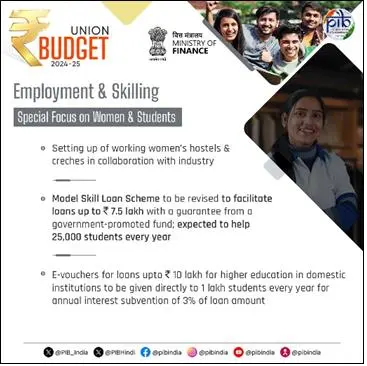The Union Budget 2024-25 delineates a visionary roadmap for transforming India into a developed nation, termed “Viksit Bharat.” This strategy encompasses nine pivotal priorities designed to generate abundant opportunities for all citizens and propel the country towards sustainable development and economic prosperity. The key priorities are:
- Enhancing Agricultural Productivity and Resilience: Focus on modernizing agricultural practices to increase yield and ensure food security.
- Skilling and Employment: Prioritizing the development of skills that match industry requirements and creating ample job opportunities to ensure economic stability and individual empowerment.
- Inclusive Human Resource Development and Social Justice: Ensuring equitable access to education and resources, promoting social justice, and uplifting marginalized communities.
- Revitalizing Manufacturing and Services Sectors: Strengthening these sectors to boost economic growth and create job opportunities.
- Urban Development: Enhancing urban infrastructure and living standards to accommodate the growing urban population.
- Energy Security: Fostering sustainable energy practices and ensuring a stable energy supply to support industrial and domestic needs.
- Infrastructure Development: Building and upgrading infrastructure to support economic activities and improve connectivity.
- Innovation, Research & Development: Investing in R&D to foster innovation, technological advancements, and competitive edge in the global market.
- Next Generation Reforms: Implementing reforms that promote efficiency, transparency, and inclusivity in governance and business practices.

Emphasis on Skilling and Employment
The budget underscores the critical importance of skilling and employment in driving nation-building efforts. With a median age of 28 and 65% of the population under 35, India has a unique demographic advantage. However, bridging the skill gap remains a priority, as currently, only 51.25% of the youth are considered employable. The government’s initiatives aim to enhance this percentage and prepare the workforce for a dynamic global economy.
Government Initiatives for Skill Development
The Union Budget 2024-25 introduces several landmark initiatives:
- Centrally Sponsored Scheme: In collaboration with state governments and industry, this scheme aims to skill 20 lakh youth over five years and upgrade 1,000 Industrial Training Institutes (ITIs).
- Revised Model Skill Loan Scheme: Provides loans up to ₹7.5 lakh with government-backed guarantees, benefiting 25,000 students annually. Additionally, loans up to ₹10 lakh for higher education with annual interest subvention of 3% for 1 lakh students each year.

“Discover the Union Budget 2024-25’s ‘Pathway of Viksit Bharat,’ focusing on nine priorities to drive India’s growth towards becoming a developed nation.”

Continued Support for Established Programs
- National Policy on Skill Development & Entrepreneurship (NPSDE): Aims to bridge skill gaps, enhance industry engagement, and expand apprenticeship opportunities.
- Pradhan Mantri Kaushal Vikas Yojana (PMKVY): Has trained over 1.42 crore individuals since 2015, integrating over 1,000 educational institutions as Skill India Centres.
- Craftsmen Training Scheme (CTS): Focuses on long-term vocational training, with notable growth in female participation.
- Jan Shikshan Sansthan (JSS): Targets non/neo-literates, having trained 26.36 lakh individuals from FY19 to FY24, with women constituting 82% of beneficiaries.
- National Apprenticeship Promotion Scheme (NAPS): Engaged 32.38 lakh apprentices, with significant female participation growth.
- Entrepreneurship Training: Provided by institutions like NIESBUD and IIE, training 4.64 lakh individuals from FY19 to FY24.
- Skill India Digital Hub: Launched in August 2023, engaging over 60 lakh learners and integrating multiple government initiatives.
Targeting Emerging Sectors and Global Standards
- Green Hydrogen and PM Vishwakarma Initiative: Focused on skilling in emerging sectors.
- Skill India International Centers: Promoting mutual recognition of qualifications and international mobility through partnerships with countries like Australia and Germany.
Innovative Financing and Industry Collaboration
- National Skill Development Corporation (NSDC): Drives industry collaboration through innovative finance mechanisms like the Skill Impact Bond, training thousands of youths, including a significant proportion of women.
- Directorate General of Training (DGT): Partners with major corporations to provide industry-relevant skills training.
Employment Enhancement Initiatives
The government has unveiled comprehensive schemes to enhance employment opportunities for 4.1 crore youth over five years:
- Employment-Linked Incentive Schemes:
- Scheme A: Offers up to ₹15,000 for first-time employees registered with EPFO.
- Scheme B: Provides incentives for EPFO contributions for both employees and employers in the manufacturing sector.
- Scheme C: Reimburses up to ₹3,000 per month for two years towards EPFO contributions for each additional employee.
- Internship Scheme: Provides opportunities for 1 crore youth in 500 top companies.
Promoting Women’s Workforce Participation
- Establishing working women hostels and crèches.
- Women-specific skilling programs.
- Promoting market access for women-led Self-Help Group (SHG) enterprises.
Conclusion
India faces significant challenges with its skill gap, but the government’s proactive initiatives have shown progress in bridging this divide. These comprehensive efforts aim to address talent shortages and prepare India’s youth for a global economy, highlighting the need for sustained investment and collaboration.
Read more:- Transitioning from Old to New Tax Regime Post Budget 2024



Pingback: FAQs Issued by CBDT on the New Capital Gains Tax Regime Proposed in the Union Budget 2024-25 - CA ALOK KUMAR